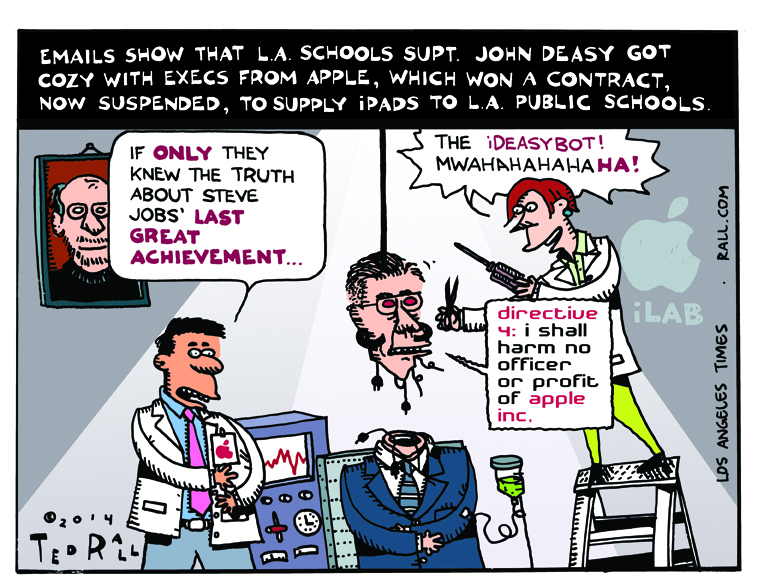Originally published by ANewDomain.net:
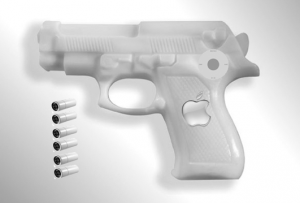 aNewDomain exclusive Auckland, NZ, 01.04.2015 — Apple is soon to announce a smart firearm and will unveil the new weapon, called the Apple Gun, at a special scheduled to coincide with next spring’s Las Vegas Shooting Hunting and Outdoor Trade show, the largest gathering of gun fans and dealers in the nation.
aNewDomain exclusive Auckland, NZ, 01.04.2015 — Apple is soon to announce a smart firearm and will unveil the new weapon, called the Apple Gun, at a special scheduled to coincide with next spring’s Las Vegas Shooting Hunting and Outdoor Trade show, the largest gathering of gun fans and dealers in the nation.
The event, according to documents leaked to aNewDomain reporters at the Auckland Gun Show in New Zealand, will be timed to coincide with Apple’s 40th anniversary celebration in early April 2016.
The Apple Gun is a continuation of the Cupertino giant’s strategy of expanding its reach beyond personal computing into other products, like its planned Apple Car and widely-anticipated Apple Drone, sources close to the effort told aNewDomain.
Legal correspondent T. E. Wing unearthed Apple’s Apple Gun patent application, as filed with US Patent & Trademark Office, in August 2014. A rendering of the Apple Gun as Apple lawyers drew it in the Apple Gun patent application is below. At this writing, the patent is still pending.
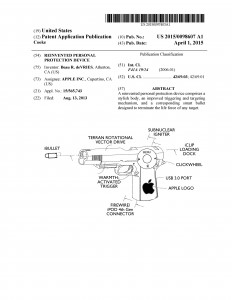 Apple PR woman Katie Cotton refused to comment on the Apple Gun information that sources revealed to aNewDomain, saying Apple does not confirm or deny “rumors or unannounced products, however slim and sexy.” Apple CEO Tim Cook, contacted via his Google + account, refused to comment on the report, saying simply: “Imagine.”
Apple PR woman Katie Cotton refused to comment on the Apple Gun information that sources revealed to aNewDomain, saying Apple does not confirm or deny “rumors or unannounced products, however slim and sexy.” Apple CEO Tim Cook, contacted via his Google + account, refused to comment on the report, saying simply: “Imagine.”
Luckily, we don’t have to. Early ad copy obtained by aNewDomain reveals a forthcoming Apple-branded firearm that is is “beautiful, simple and accurate.” Not necessarily affordable to every consumer, Apple Gun is about to do for personal protection what the Apple iPhone did to the telephone, sources say.
The ad copy, leaked to aNewDomain at the New Zealand firearms convention early today, continues:
Imagine a firearm that doesn’t make a sound when fired. A weapon that doesn’t look ominous, but to the contrary, sports beautiful design that fits in at the office, at Whole Foods, even in the classroom. A gun with state-of-the-art quality front and center, making accidental maimings a thing of the past.
“A weapon for design freaks and liberals,” comments one source, speaking on condition of anonymity. “It’s brilliant. And deadly.”
“Though it’s going to surprise some of the company’s crunchy NPR-listening client base, this is a logical move for Apple,” said Shell Jackson, an analyst at Goldman Sachs’ tech division. And it’s just the beginning.
“Guns are a $32 billion a year business in the United States. Not only is Apple Gun a smartplay for market share in an industry that hasn’t seen a major design development since the demise of the flintlock, it will familiarize the red states – currently PC country – with the Apple brand.” He adds:
“Once Apple Gun has achieved significant market share, it will expand throughout the weapons and munitions sector into high-caliber heavy weapons, long-range missiles and laserguided bombs, armed drones, maybe even nuclear.”
Featuring smooth, clean lines, a clickwheel and translucent whiteness, Apple Gun is the culmination of Steve Jobs’ last product initiative, Project DeepSix, which was initiated 17 months before his death with the goal of reimagining the handgun. “What if guns were invented today? They wouldn’t be hypermasculine death machines for dimwitted nativist jocks. They’d be pretty. They’d have multiple functionalities: text messaging and other telecommunications, music player, flashlight, sports fitness applications, all tethered to your iPhone and uploaded to iCloud. They’d simplify our lives with beautiful design,” Jobs, a Buddhist known for his angry rants, told his team from his hospital bed, angrily yet calmly.
The Apple Gun “will free the gun from the gun owner,” the source said.
According to an internal company memo accidentally shared to a Dropbox folder owned by an Indian restaurant in Mountain View, California, Apple Gun “will revolutionize the gun concept” by “freeing the gun from the gun owner.”
Let’s say, for example, that you’re worried about someone breaking into your home while you’re at work. Simply leave Apple Gun on a table near your front door. A laser-activated sensor will notify you if someone enters, flash their image to your iPhone, which then relays to your Apple Watch, which must be fully charged to work properly.
If you don’t know the person, press “Y” to fire. If it’s your cleaning lady, press “N.”
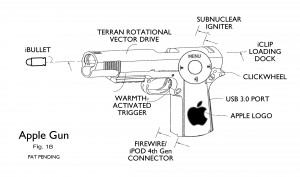 What if you want to kill someone, or many someones, but you are too busy to stop them or lay in wait for them? Subscribers to the premium version of Apple’s iCloud storage service can load high-resolution photographs or personal descriptions of the target subjects, rank them in order of kill priority, sync up their Apple Gun, and violà! Just like that, thanks to Apple’s patented iHead facial-recognition software, whenever the intended victim steps anywhere near the line of fire, termination is automatic and guaranteed.
What if you want to kill someone, or many someones, but you are too busy to stop them or lay in wait for them? Subscribers to the premium version of Apple’s iCloud storage service can load high-resolution photographs or personal descriptions of the target subjects, rank them in order of kill priority, sync up their Apple Gun, and violà! Just like that, thanks to Apple’s patented iHead facial-recognition software, whenever the intended victim steps anywhere near the line of fire, termination is automatic and guaranteed.
The twin problem is still being worked on.
A brief look at the Apple Gun patent application reveals a number of intriguing firearm tech features.
Merging traditional bullets and heat-seeking missile technology, Apple’s proprietary iBullet ammunition costs $100 each and will be sold in clips of 20.
Thanks to special casing and the replacement of gunpowder by the release of an electric charge, the dynamic rotation of the iBullet is fueled by the spin of the Earth’s electromagnetic field, working around the laws of physics that create that unpleasant bang in traditional modern firearms.
The last thing you’ll hear before an Apple Gun kills you is a soft “poof,” like the sound emanating from an especially mellow baby blowing a very tiny bubble.
Relatively small at the traditional barrel equivalent of .375 caliber, Apple Bullets locate a target’s heartbeat and follow it anywhere, even around corners. Upon striking flesh, DNA analysis determines the species of the victim as well as its obesity (or lack thereof), telling the bullet to travel the precise distance to the center of its heart before releasing its explosive charge.
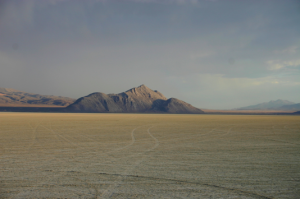
Apple engineers on the gun team spent two years killing, and attempting to kill various life forms at a secret research facility in Nevada’s Black Rock Desert, near the site of the annual Burning Man festival. It is pictured at left.
“It’s a combination of experimentation, algorithms and good luck,” explained one member of the team on the condition of anonymity. “Provided the gun is fully charged” – battery power, company insiders concede, has not yet been fully optimized – “you can take out a rhesus monkey, a rattlesnake, a groundhog, a capybara or a drug-enraged human sociopath at 250 meters with 99.965% accuracy,” he said.
I for one am excited — no, thrilled — about the forthcoming Apple Gun. You know, I wouldn’t buy a gun. But you can take my smartgun out of my cold dead hands.
For aNewDomain, I’m Red Tall.

